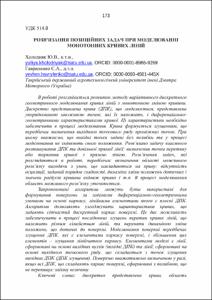Please use this identifier to cite or link to this item:
http://elar.tsatu.edu.ua/handle/123456789/16458Full metadata record
| DC Field | Value | Language |
|---|---|---|
| dc.contributor.author | Холодняк, Юлія Володимирівна | - |
| dc.contributor.author | Kholodniak, Yuliia | - |
| dc.contributor.author | Гавриленко, Євген Андрійович | - |
| dc.contributor.author | Havrylenko, Yevhen | - |
| dc.date.accessioned | 2023-03-01T23:45:03Z | - |
| dc.date.available | 2023-03-01T23:45:03Z | - |
| dc.date.issued | 2022 | - |
| dc.identifier.citation | Холодняк Ю.В., Гавриленко Є.А. Розв'язання позиційних задач при моделюванні монотонних кривих ліній Сучасні комп’ютерні та інформаційні системи і технології: матеріали ІІІ Всеукраїнської наук.- практ. інтернет-конф. Запоріжжя, 12-19 грудня 2022 р. Запоріжжя: ТДАТУ, 2022. С.173-181. | uk |
| dc.identifier.uri | http://elar.tsatu.edu.ua/handle/123456789/16458 | - |
| dc.description.abstract | UK: В роботі розглядається розвиток методу варіативного дискретного геометричного моделювання кривих ліній з монотонною зміною кривини. Дискретно представлена крива (ДПК), що моделюється, представлена упорядкованою множиною точок, які їх належать, і диференціально геометричними характеристиками кривої. Ці характеристики необхідно забезпечити в процесі моделювання. Крива формується згущенням, що передбачає визначення вихідного точкового ряду проміжних точок. При цьому вважаємо, що вихідні точки задані без похибки та у процесі моделювання не змінюють свого положення. Розв’язано задачу взаємного розташування ДПК та довільної прямої лінії: визначення точки перетину або торкання кривої з прямою лінією. Розв’язання задач, які розглядаються в роботі, передбачає визначення області можливого розв’язку виходячи з умов, що накладаються на криву: відсутність осциляції, заданий порядок гладкості, динаміка зміни положень дотичних і значень радіусів кривини вздовж кривих і т.п. В процесі моделювання область можливого розв’язку уточнюється. Запропоновані алгоритми можуть бути використані для формування поверхонь за заданими диференціально-геометричними умовами на основі каркасу, лінійними елементами якого є плоскі ДПК. Алгоритми дозволяють узгоджувати характеристики кривих, що задають сітчастий дискретний каркас поверхні. Це дає можливість забезпечувати в процесі послідовних згущень перетин кривих ліній, що належать різним сімействам ліній, та керувати динамікою зміни положень, що дотичні до поверхні. Моделювання поверхні передбачає згущення ДПК, які є елементами каркасу поверхні, і збільшення цих елементів – згущення лінійчатого каркасу. Елементами моделі є лінії, сформовані на основі вихідних вузлів (вихідні ДПК) та лінії, сформовані на основі вихідного точкового ряду, що складається з точок згущення вихідних ДПК (ДПК згущення). Поверхню вважатимемо визначеною у разі, якщо всі ДПК, що складають каркас поверхні, сформовані з похибкою, що не перевищує задану величину.|||||||||||||||||||| EN: The paper considers the development of the method of variable discrete geometric modeling of curved lines with a monotonous change in curvature. The discretely represented curve (DRC) being modeled is represented by an ordered set of points that belong to them and the differential geometric characteristics of the curve. These characteristics must be ensured during the modeling process. The curve is formed by thickening, which involves determining the initial point series of intermediate points. At the same time, we believe that the starting points are set without error and do not change their position during the modeling process. The problem of the mutual location of the DRC and an arbitrary straight line has been solved: determining the point of intersection or contact of a curve with a straight line. The solution of the problems considered in the work involves determining the area of a possible solution based on the conditions imposed on the curve: the absence of oscillation, the given order of smoothness, the dynamics of changes in the tangent positions and the values of the radii of curvature along the curves, etc. In the process of modeling, the area of a possible solution is refined.The proposed algorithms can be used to form surfaces according to the given differential-geometric conditions on the basis of the framework, the linear elements of which are flat DRCs. Algorithms allow you to match the characteristics of the curves that define the mesh discrete frame of the surface. This makes it possible to ensure the intersection of curved lines belonging to different families of lines in the process of successive thickenings, and to control the dynamics of changes in positions tangent to the surface. Modeling the surface involves the thickening of the DRC, which are the elements of the surface frame, and the increase of these elements - the thickening of the linear frame. The elements of the model are the lines formed on the basis of the original nodes (output DRCs) and the lines formed on the basis of the original point series consisting of points of condensation of the original DRCs (condensation DRCs). The surface will be considered defined if all the DRCs that make up the frame of the surface are formed with an error that does not exceed the specified value. | uk |
| dc.language.iso | uk | uk |
| dc.publisher | Запоріжжя: ТДАТУ | uk |
| dc.subject | дискретно представлена крива | uk |
| dc.subject | область розташування кривої | uk |
| dc.subject | другий порядок гладкості | uk |
| dc.subject | монотонність зміни кривизни | uk |
| dc.subject | discretely represented curve | uk |
| dc.subject | region of curve location | uk |
| dc.subject | second order of smoothness | uk |
| dc.subject | monotonicity of curvature change | uk |
| dc.title | РОЗВ'ЯЗАННЯ ПОЗИЦІЙНИХ ЗАДАЧ ПРИ МОДЕЛЮВАННІ МОНОТОННИХ КРИВИХ ЛІНІЙ | uk |
| dc.title.alternative | SOLUTION OF POSITIONAL PROBLEMS AT MODELING OF MONOTONOUS CURVES | uk |
| dc.type | Article | uk |
| local.identifier.udc | 514.8 | uk |
| Appears in Collections: | Кафедра Комп'ютерні науки | |
Show simple item record
CORE Recommender
???jsp.display-item.check???
Items in DSpace are protected by copyright, with all rights reserved, unless otherwise indicated.

